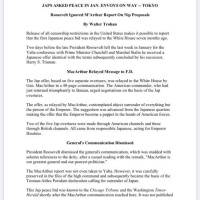Albert Einstein is heading out for his daily stroll and has to pass through two doorways. First he walks through the green door, and then through the red one. Or wait — did he go through the red first and then the green? It must have been one or the other. The events had have to happened in a sequence, right?
Related stories
Battle between quantum and thermodynamic laws heats up
Cosmic test backs 'quantum spookiness'
Physicists propose football-pitch-sized quantum computer
More related stories
Not if Einstein were riding on one of the photons ricocheting through Philip Walther's lab at the University of Vienna. Walther's group has shown that it is impossible to say in which order these photons pass through a pair of gates as they zip around the lab. It's not that this information gets lost or jumbled — it simply doesn't exist. In Walther's experiments, there is no well-defined order of events.
This finding1 in 2015 made the quantum world seem even stranger than scientists had thought. Walther's experiments mash up causality: the idea that one thing leads to another. It is as if the physicists have scrambled the concept of time itself, so that it seems to run in two directions at once.
In everyday language, that sounds nonsensical. But within the mathematical formalism of quantum theory, ambiguity about causation emerges in a perfectly logical and consistent way. And by creating systems that lack a clear flow of cause and effect2, researchers now think they can tap into a rich realm of possibilities. Some suggest that they could boost the already phenomenal potential of quantum computing. “A quantum computer free from the constraints of a predefined causal structure might solve some problems faster than conventional quantum computers,” says quantum theorist Giulio Chiribella of the University of Hong Kong.
What's more, thinking about the 'causal structure' of quantum mechanics — which events precede or succeed others — might prove to be more productive, and ultimately more intuitive, than couching it in the typical mind-bending language that describes photons as being both waves and particles, or events as blurred by a haze of uncertainty.
And because causation is really about how objects influence one another across time and space, this new approach could provide the first steps towards uniting the two cornerstone theories of physics and resolving one of the most profound scientific challenges today. “Causality lies at the interface between quantum mechanics and general relativity,” says Walther's collaborator Časlav Brukner, a theorist at the Institute for Quantum Optics and Quantum Information in Vienna, “and so it could help us to think about how one could merge the two conceptually.”
Tangles in time
Causation has been a key issue in quantum mechanics since the mid-1930s, when Einstein challenged the apparent randomness that Niels Bohr and Werner Heisenberg had installed at the heart of the theory. Bohr and Heisenberg's Copenhagen interpretation insisted that the outcome of a quantum measurement — such as checking the orientation of a photon's plane of polarization — is determined at random, and only in the instant that the measurement is made. No reason can be adduced to explain that particular outcome. But in 1935, Einstein and his young colleagues Boris Podolsky and Nathan Rosen (now collectively denoted EPR) described a thought experiment that pushed Bohr's interpretation to a seemingly impossible conclusion.
The EPR experiment involves two particles, A and B, that have been prepared with interdependent, or 'entangled', properties. For example, if A has an upward-pointing 'spin' (crudely, a quantum property that can be pictured a little bit like the orientation of a bar magnet), then B must be down, and vice versa.
Both pairs of orientations are possible. But researchers can discover the actual orientation only when they make a measurement on one of the particles. According to the Copenhagen interpretation, that measurement doesn't just reveal the particle's state; it actually fixes it in that instant. That means it also instantly fixes the state of the particle's entangled partner — however far away that partner is. But Einstein considered this apparent instant action at a distance impossible, because it would require faster-than-light interaction across space, which is forbidden by his special theory of relativity. Einstein was convinced that this invalidated the Copenhagen interpretation, and that particles A and B must already have well-defined spins before anybody looks at them.
Measurements of entangled particles show, however, that the observed correlation between the spins can't be explained on the basis of pre-existing properties. But these correlations don't actually violate relativity because they can't be used to communicate faster than light. Quite how the relationship arises is hard to explain in any intuitive cause-and-effect way.
But what the Copenhagen interpretation does at least seem to retain is a time-ordering logic: a measurement can't induce an effect until after it has been made. For event A to have any effect on event B, A has to happen first. The trouble is that this logic has unravelled over the past decade, as researchers have realized that it is possible to imagine quantum scenarios in which one simply can't say which of two related events happens first.
Classically, this situation sounds impossible. True, we might not actually know whether A or B happened first — but one of them surely did. Quantum indeterminacy, however, isn't a lack of knowledge; it's a fundamental prohibition on pronouncing on any 'true state of affairs' before a measurement is made.
Ambiguous action
Brukner's group in Vienna, Chiribella's team and others have been pioneering efforts to explore this ambiguous causality in quantum mechanics3, 4. They have devised ways to create related events A and B such that no one can say whether A preceded and led to (in a sense 'caused') B, or vice versa. This arrangement enables information to be shared between A and B in ways that are ruled out if there is a definite causal order. In other words, an indeterminate causal order lets researchers do things with quantum systems that are otherwise impossible.
The trick they use involves creating a special type of quantum 'superposition'. Superpositions of quantum states are well known: a spin, for example, can be placed in a superposition of up and down states. And the two spins in the EPR experiment are in a superposition — in that case involving two particles. It's often said that a quantum object in a superposition exists in two states at once, but more properly it simply cannot be said in advance what the outcome of a measurement would be. The two observable states can be used as the binary states (1 and 0) of quantum bits, or qubits, which are the basic elements of quantum computers.
The researchers extend this concept by creating a causal superposition. In this case, the two states represent sequences of events: a particle goes first through gate A and then through gate B (so that A's output state determines B's input), or vice versa.
In 2009, Chiribella and his co-workers came up with a theoretical way to do an experiment like this using a single qubit as a switch that controls the causal order of events experienced by a particle that acts as second qubit3. When the control-switch qubit is in state 0, the particle goes through gate A first, and then through gate B. When the control qubit is in state 1, the order of the second qubit is BA. But if that qubit is in a superposition of 0 and 1, the second qubit experiences a causal superposition of both sequences — meaning there is no defined order to the particle's traversal of the gates (see 'Trippy journeys').
Related stories
Battle between quantum and thermodynamic laws heats up
Cosmic test backs 'quantum spookiness'
Physicists propose football-pitch-sized quantum computer
More related stories
Not if Einstein were riding on one of the photons ricocheting through Philip Walther's lab at the University of Vienna. Walther's group has shown that it is impossible to say in which order these photons pass through a pair of gates as they zip around the lab. It's not that this information gets lost or jumbled — it simply doesn't exist. In Walther's experiments, there is no well-defined order of events.
This finding1 in 2015 made the quantum world seem even stranger than scientists had thought. Walther's experiments mash up causality: the idea that one thing leads to another. It is as if the physicists have scrambled the concept of time itself, so that it seems to run in two directions at once.
In everyday language, that sounds nonsensical. But within the mathematical formalism of quantum theory, ambiguity about causation emerges in a perfectly logical and consistent way. And by creating systems that lack a clear flow of cause and effect2, researchers now think they can tap into a rich realm of possibilities. Some suggest that they could boost the already phenomenal potential of quantum computing. “A quantum computer free from the constraints of a predefined causal structure might solve some problems faster than conventional quantum computers,” says quantum theorist Giulio Chiribella of the University of Hong Kong.
What's more, thinking about the 'causal structure' of quantum mechanics — which events precede or succeed others — might prove to be more productive, and ultimately more intuitive, than couching it in the typical mind-bending language that describes photons as being both waves and particles, or events as blurred by a haze of uncertainty.
And because causation is really about how objects influence one another across time and space, this new approach could provide the first steps towards uniting the two cornerstone theories of physics and resolving one of the most profound scientific challenges today. “Causality lies at the interface between quantum mechanics and general relativity,” says Walther's collaborator Časlav Brukner, a theorist at the Institute for Quantum Optics and Quantum Information in Vienna, “and so it could help us to think about how one could merge the two conceptually.”
Tangles in time
Causation has been a key issue in quantum mechanics since the mid-1930s, when Einstein challenged the apparent randomness that Niels Bohr and Werner Heisenberg had installed at the heart of the theory. Bohr and Heisenberg's Copenhagen interpretation insisted that the outcome of a quantum measurement — such as checking the orientation of a photon's plane of polarization — is determined at random, and only in the instant that the measurement is made. No reason can be adduced to explain that particular outcome. But in 1935, Einstein and his young colleagues Boris Podolsky and Nathan Rosen (now collectively denoted EPR) described a thought experiment that pushed Bohr's interpretation to a seemingly impossible conclusion.
The EPR experiment involves two particles, A and B, that have been prepared with interdependent, or 'entangled', properties. For example, if A has an upward-pointing 'spin' (crudely, a quantum property that can be pictured a little bit like the orientation of a bar magnet), then B must be down, and vice versa.
Both pairs of orientations are possible. But researchers can discover the actual orientation only when they make a measurement on one of the particles. According to the Copenhagen interpretation, that measurement doesn't just reveal the particle's state; it actually fixes it in that instant. That means it also instantly fixes the state of the particle's entangled partner — however far away that partner is. But Einstein considered this apparent instant action at a distance impossible, because it would require faster-than-light interaction across space, which is forbidden by his special theory of relativity. Einstein was convinced that this invalidated the Copenhagen interpretation, and that particles A and B must already have well-defined spins before anybody looks at them.
Measurements of entangled particles show, however, that the observed correlation between the spins can't be explained on the basis of pre-existing properties. But these correlations don't actually violate relativity because they can't be used to communicate faster than light. Quite how the relationship arises is hard to explain in any intuitive cause-and-effect way.
But what the Copenhagen interpretation does at least seem to retain is a time-ordering logic: a measurement can't induce an effect until after it has been made. For event A to have any effect on event B, A has to happen first. The trouble is that this logic has unravelled over the past decade, as researchers have realized that it is possible to imagine quantum scenarios in which one simply can't say which of two related events happens first.
Classically, this situation sounds impossible. True, we might not actually know whether A or B happened first — but one of them surely did. Quantum indeterminacy, however, isn't a lack of knowledge; it's a fundamental prohibition on pronouncing on any 'true state of affairs' before a measurement is made.
Ambiguous action
Brukner's group in Vienna, Chiribella's team and others have been pioneering efforts to explore this ambiguous causality in quantum mechanics3, 4. They have devised ways to create related events A and B such that no one can say whether A preceded and led to (in a sense 'caused') B, or vice versa. This arrangement enables information to be shared between A and B in ways that are ruled out if there is a definite causal order. In other words, an indeterminate causal order lets researchers do things with quantum systems that are otherwise impossible.
The trick they use involves creating a special type of quantum 'superposition'. Superpositions of quantum states are well known: a spin, for example, can be placed in a superposition of up and down states. And the two spins in the EPR experiment are in a superposition — in that case involving two particles. It's often said that a quantum object in a superposition exists in two states at once, but more properly it simply cannot be said in advance what the outcome of a measurement would be. The two observable states can be used as the binary states (1 and 0) of quantum bits, or qubits, which are the basic elements of quantum computers.
The researchers extend this concept by creating a causal superposition. In this case, the two states represent sequences of events: a particle goes first through gate A and then through gate B (so that A's output state determines B's input), or vice versa.
In 2009, Chiribella and his co-workers came up with a theoretical way to do an experiment like this using a single qubit as a switch that controls the causal order of events experienced by a particle that acts as second qubit3. When the control-switch qubit is in state 0, the particle goes through gate A first, and then through gate B. When the control qubit is in state 1, the order of the second qubit is BA. But if that qubit is in a superposition of 0 and 1, the second qubit experiences a causal superposition of both sequences — meaning there is no defined order to the particle's traversal of the gates (see 'Trippy journeys').

























